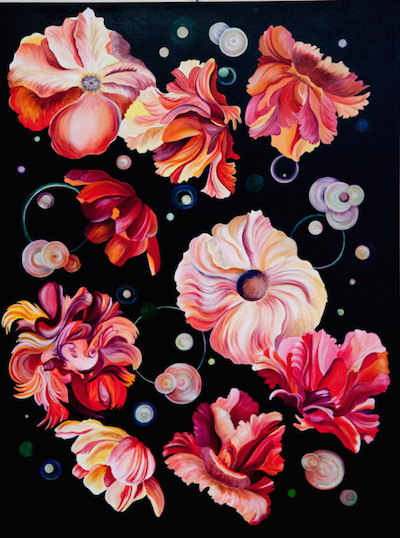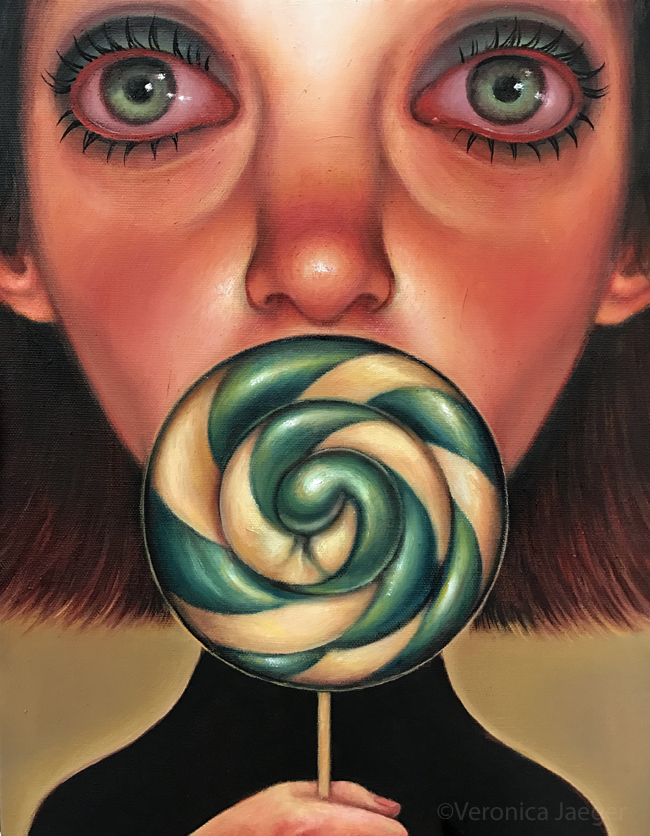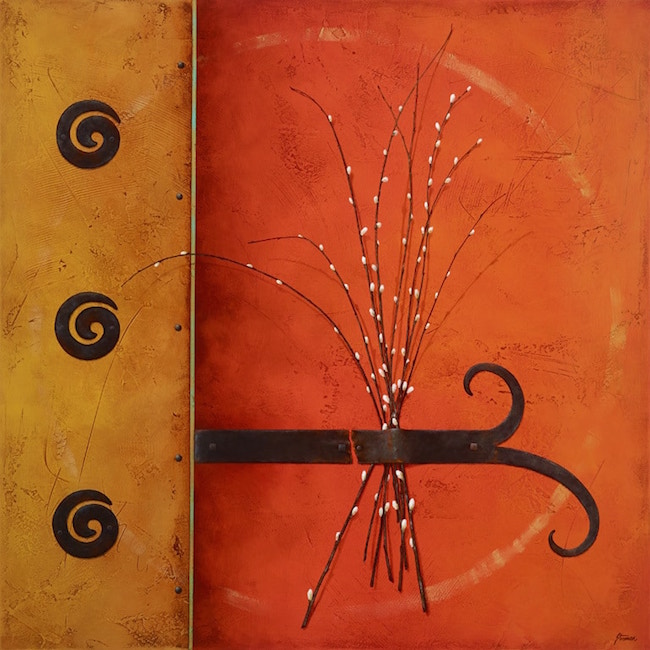A catalog of your art can be a snapshot of your career at a moment in time or a retrospective documenting your entire life’s work.
With the advent of on-demand, inexpensive publishing, every artist should be using catalogs to promote their art. Read why you need one and what to include in it.
11.4.24 – Hid this section because the IG live is gone and I can’t find it! (Kristyn)
Here’s a video on Instagram that gives you an overview of artist catalogs and real examples from artists.
Please ignore the outdated info at the beginning.
A printed artist catalog is tactile. It can be placed in a gallery setting and held in one’s hands. It can be sent through the mail with a handwritten note as a gift to a VIP.
I also recommend a physical catalog because there’s nothing like seeing your art in print.
Printed catalogs can also be sold. However, catalogs of your art are rarely money-making ventures. I encourage you to think of them as marketing pieces and documentation rather than products you might sell for profit.
Use the checklist below to ensure that your catalog has all of the components to make it a lasting document of your art—one that you are proud of.
Pre-Project Checklist for Your Artist Catalog
Focus
Before you begin, you must determine the focus of your catalog. Just as you curate an exhibition of your art, you curate the content of your catalog.
Unless your catalog is a retrospective, you won’t be served by putting everything you’ve made into a catalog. Instead, tighten it up and focus on a single solo show or body of work.
High-Quality Images
Don’t even think about a catalog until you have professional photos taken. Excellent print quality demands high-resolution images that show off your work in great detail.
Now that you have the focus and the images, you can begin to think about the inside.
Contents of Your Catalog
Cover
Your name
Featured image
Title of exhibition or body of work
Title Page
Title of publication
Your name
Website address
Flipside of Title Page
Copyright notice and date
Credits: Designer, Editor, Proofreader, Essayist, Photographer, etc.
ISBN number (if you use one)
Instructions for ordering copies
Your contact information and social media sites

Image Formatting and Placement
Images placed next to one another in the catalog should look good together. Remember that you’re curating your art and want to show it in the best light.
Don’t forget the credit lines! You don’t need your name with every image unless the catalog includes work other than your own, but every image should include:
Title, medium, HxWxD, and date (if you use dates).
You might also include © notice and photography credit.
Text
The written portion of your catalog is an opportunity to tell people about you and make deeper connections.
“About <Your Name>” can be placed at the front or back of the catalog. It might be written in the form of a bio or have the following subheadings:
- Exhibitions
- Public Collections
- Bibliography
- Education
Your artist statement can be on or near your About page or placed next to the images.
If you have representation, include a Galleries section to tell readers where to find your work.
An essay by someone else (a curator, critic, or art historian) can contextualize your art and would be placed at or near the beginning of the artist catalog. This will also elevate the prestige of your work.
Add stories about individual pieces next to the images.
Prices
Rather than printing prices in your catalog, insert a separate piece of paper with a price list. This allows you more flexibility with pricing.
Take advantage of your new catalog as soon as it’s published. If you’re hard at work in the studio, it will soon be out of date.

This post was originally published on April 20, 2017, and has been updated with original comments intact.




42 thoughts on “Artist Catalogs: Why You Need Them, What to Include, and How to Use”
Thanks for another great topic. I agree that a catalog is a great marketing tool and I’d love to know more about “on-demand, inexpensive printing” options for printing color images. What do you estimate a color catalog will cost?
I’ve recently had a small (40 page) booklet printed locally that had only 4 color pages that cost me about $15 each, not including design fees. I’ve looked into Blurb and Shutterfly too, and those seem to run about $25-50 per copy for what I’d want. Another trade paperback I’ve done using CreateSpace (104 pages), costs me about $3.00 per copy but the only color is on the cover. As I recall, to add color to the interior would have been much more costly.
Is there another POD service that does inexpensive quality color printing that I don’t know about?
Ellie: I think others will have better input. I know clients who love Magcloud. I had a nice hard-cover, full-color book produced at Apple (color on all pages) for $25. I think other choices might be more affordable.
Thanks, Alyson. I’ll keep an eye for other input about affordable printing. I’ve heard you can get high quality color printing done affordably in Singapore for large runs, but that’s not for most artists and not for a catalog.
Hi Ellie—I strongly recommend PSPrint.
I’ve done over 100 jobs with them, both for myself and for clients, and I’ve always been happy with their quality. Also, their prices are better than any I’ve seen, especially when they run a sale promotion, which they do often. (Booklet prices as of today: 8.5 in x 5 in, 16 pages, 100 lb gloss text, full color, 1000 quantity = $402 [$0.40 each!] + shipping)
Full disclosure: I’m NOT an affiliate and do not benefit in any way if you use PSPrint’s services. I’m just a very happy customer.
Ellie and Alyson;
I really love Smartpress.com
They’re wonderful to work with, very reasonable, and their website is to easy. They offer a Perfectbound (glued binder) 8×8, and a very simple, free paper stock/coating sample book.
I’ve had multi-version business cards and postcards printed that are beautiful:
https://smartpress.com/shop/custom-booklets#cp=1&cph=820
I actually work for an artist, and he lost most of his work to the California fires. I have photos in old albums hidden away that don’t do his art justice and I’m trying to figure out how to catalog them properly for him to share and for the next generation to have. I’m having trouble starting this task, do you have any tips that’ll guide me in the best direction?
Vic: I want to understand the semantics. Cataloguing (a verb) is more like taking inventory. Making a catalog to hold in your hands is taking that inventory and laying it out with text. If you’re talking about putting them in order, I recommend Artwork Archive: https://artworkarchive.com
I would recommend either web address or email contact along with a QR code on pages with art. Like webpages no one wants to go back to look for info. Does not have to be big. It can be small yet legible at the bottom of the page as a design element.
Another thing that slows down the viewer is the one sentence story about the art. One can actually see how a caption will slow down a visitor to a gallery then they look at the art again. Critical is ONE sentence, not an essay.
I think there can be more than one sentence as long as the text is meaningful and engaging. (I responded to the QR code idea below – to Jennifer Kirby.)
I am planning a catalogue (though I haven’t painted a single painting that is to go into it, yet).
I love Diane’s idea of the QR code.
Jennifer: The trick with the QR code is that it has to go to a Web page that is meaningful. Home pages from a QR code aren’t helpful.
I am not crazy about QR codes on every page – too much visual competition with the art.
I have seen some late career artist produce catalogs for retrospective shows as well as coffee table books. To my knowledge they always seem to be unprofitable for the artist except for the exposure. Many times they are profitable for the gallery I have heard of galleries footing the bill for a catalogue for a retrospective show. I was under the impression that websites are the best way to keep a catalogue of your work. Putting it in print seems to be a bit retro and highly expensive. Especially for early career artist unless it is a short brochure but that would become outdated quickly. Not sure where the benefit lies. I think there is a danger in looking for a bargain printer as the poor quality could shoot you in the foot. Sorry for the scepticium
Kevin: I have had so many clients benefit from having a catalog. People who love art are tactile. It is impressive and shows you’re organized.
Definitely not a money-maker, as I said above. It’s a marketing tool. And so much cheaper than sending slides (which we did 20 years ago!).
I did a wholesale greeting card catalog of 80 pieces of my artwork, specifically for retailers. I had a graphic designer do the design work. She created my original website, so she had my vision/branding already. It was costly, but I feel worth it. My sales reps were happy to share it and it was well received. I think it’s about time to create a new catalog with my new abstract collection! Thank you for the suggestions, they are very helpful!
Monica: Great idea! It would be interesting to measure the ROI (return on investment) of having that catalog. How much business did it bring you?
I have a colleague who does a Shutterfly book each year of the work he’s done. When he’s at shows he brings the last few years of books, it’s an easy way for potential collectors to familiarize themselves with his work.
I have meant to start this practice myself. Thanks for the reminder!
Jennifer: No better time to start than now! Happy to see your name here. 🙂
I have never had professional photos taken of my work and I am pretty sure I never will because of the cost. I question this advice and wonder if you care to explain the ROI of paying a professional photographer in this day and age when the technology to make high-resolution quality photos ourselves is quite accessible. I am looking forward to the class and I thank you for your generosity in providing a lot of valuable content for free in between the classes.
In response to Tajana — It’s worth the cost to have professional photos taken of your work, for many more reasons than just putting them in a catalog (which has its positive reasons too). In today’s day and age while technology can create high-resolution images for ourselves, it doesn’t replace the skill and technical know-how of professional photographers who can put your artwork in the best lighting, adjust the gamut of colors to match your original colors, managing any glares on the surface of your work, etc.. If you look around or network with other artists in your area, I’m sure you’ll find a couple different art photographers who could give you professional quality photos of your work for a reasonable rate.
I have a high quality camera for use in other projects, but having a professional take photos of your work enables them to view your work objectively.
The many other reasons to have high-quality and professional photographs of your artwork:
– submitting images to juried shows or to galleries in which you’re interested in representation
– providing color-accurate high-res images to a printer of giclee prints or if you ever want to make reproductions of your art
– if you sell your artwork online, you want the image of the product to be of the utmost quality
– publicity – if you ever get featured in a magazine, newspaper, documentary, etc, you want your images to be the best they can be
– documenting your work & inventory
I didn’t mean to write such a long post — your sentiment just echoed something that I had thought a couple years ago, but came over to the other side after talking with many other artists, Alyson, and getting to realize the vast difference in quality between a professional photographer and my pictures taken with my iphone, or even my camera. Unless you’re already a professional artwork photographer, in which, none of what I said above applies. Best of luck in your work 🙂
Thanks for your response, Rachel. I should have clarified that I’ve never received a feedback from galleries, show jurors, or collectors that they needed professional photographs of my paintings. I’ve used my own photos for most of the things that you listed and they were never critiqued. That’s why I decided to ask the question. I’ll take it as a recommendation, but not as a must as Alyson’s blog post indicates. Best of luck to you too! We can never have too much luck, even when we do all our homework! 🙂
Tatjana: Your photos are fine! I haven’t seen them at high resolution, but they seem good. Sometimes I tend to overstate something and make it a blanket fact because, as in this case, I’ve seen so many horrid artist photos. Even 2-D work, which should be easy to photograph.
Thanks for running a check on me.
Alyson, thanks very much for taking the time to look at my photos and for everything that you do for us, artists!
Alyson, this is so timely as just last week someone suggested I make a catalog of my work. Now after reading this article, I have some thoughts on how to approach this. And that it might actually be a good way to transition from what I was doing to what I will be doing next.
I seem to be moving through quite a lot of doors simultaneously.
I can’t wait to see what you are working on, Patrica.
Thanks for this, Alyson. It was timely for me as well as I am about halfway through a major project and have thought that I might do well either to explore producing an Artist’s Book or just turning out a catalogue as you suggest. I like the idea!
Oh, and BTW, I cannot tell you how much I appreciated your lead-up free video for the Magnetic You class! I got a tremendous amount just from that. Hearing what you had to say about making people want to ‘see’ the art has inspired me to approach the individual statements that I do for each of my pieces in a far more vibrant way! I would hug you if I could!
I’ll take a virtual hug, Victoria! Thank you.
Catalogs are also a great way to keep in the minds of collectors and past supporters. If the book is designed and produced well, and put in the right hands (given as a gift) the results can be fantastic. You never know who will see the book, or what it will lead to down the line. Past supporters are qualified and most likely know other people with the same taste and interests.
We specialize in book design and production for artists and galleries and produce tonnes of exhibition catalogs for the sole purpose of promotion and marketing. As one of the past commenters mentioned there isn’t a lot of money in book sales but it’s a great tool to promote and sell artwork.
We’re happy to answer any questions you may have about making your artbook. We are based in Canada but get a huge number of US clients due to the current exchange rate.
http://www.bookart.ca
If interested in printing a book, request a quote through our online form.
https://bookart.co/custom-quote/
This is a great idea coming at just the right time. I am in the beginning stages of a major series to be completed by September. What an excellent idea for approaching galleries! It is now incorporated into my spreadsheet. Thank you!
Nice, Donna.
As always, thank you Alyson. This post and thread are just the right gentle kick-in-the-pants to get going on a project that will be fun. Even now, I’m going through my image archive. Thousands of pix and millions of pixels: culling feels so virtuous.
However, this could easily fall into the “so many projects, so little time” category.
Susan: I love it! “culling feels so virtuous.”
Enjoy the process.
We have been using Lulu.com for about ten years. They print a very nice glossy softcover portfolio for about $9.50 each. Well worth it when a collector buys directly. We reprint with replacement images of sold works about 4 times a year. Prices on an insert. Galleries also luv them.
I would love to know how many pages in the catalog, and more about the overall look and vibe of it? Does it lie flat? Bound, stapled or–?
Iskra: I know you are asking Barny about what he gets for $9.50, but the number of pages doesn’t matter. Keep in mind that number of pages are in increments of 4 (I think – some might be 8).
I print a book annually of much of the work I created that year. I haven’t used it for marketing, more for a visual record. Last year’s book :
http://www.blurb.com/pdf_book/1413425/download?expires=1475428122&signature=f3ce1f8db900e17338b7657a96b33dd11cdfefa7
I’ve done several books with Blurb. It’s rather expensive and a bit fiddly so I’m looking for another company. But the books do look good and you can get them hard or soft cover, in different sizes.
Bummer! We have to log in to see that, Geri.
PS I include a separate sheet with all the art info and prices.
Great post about art catalogs! Thank you Alyson!
I have plans to publish a print catalog of my work. Hopefully, soon it will be a regular part of my marketing. In the mean time, I’ve produced a digital catalog of artwork (downloadable PDF) that I promoted to my list, on social media, and as an incentive to join my mailing list.
Feel free to take a look. Perhaps the format could be useful for your art marketing efforts as well!
By the way, while I agree that a print catalog is better, one advantage of a PDF is that all art images are linked to their respective web page which sends traffic directly back to my website.
Brennen: Good work! What have your results been?
Hi Alyson.
Thank you for this post.
I produced a catalogue of my work a few years back. (I’m embarrassed to say it was made back in 2012). I still have them for sale on my site and in my studio, but I look back and see the problems with it. It lacked focus. I felt I had to put ‘Everything’ in it, so it ran up the pages. Even so, I do get sales when I have shows. I find that people want to take something with them.
I have a question about the number of works to include. I paint in series in sets of ten artworks or so. Would you suggest doing a catalogue for such a low number? I ask because I paint a continuing series that I started in 2001 called Trento http://www.thomreaves.com/collections/78559. Each artwork up until 2012, when I printed the catalogue, was included in the original book. You think I should include the original series in addition to the 10 new pieces in my next catalogue, just to show the unity of the series, or just do a catalogue of the new pieces?
I use Blurb. They’ve been really good for me. Their templates are easy to use, though there’s not much room to mark up retail cost from printing cost, as it can get pricy.
All in all though, a catalogue gives people a part of you, even if they can’t afford your original works, so they’re definitely good to have.
Great post Alyson,
Wonderful suggestions all!
I use Shutterfly to print 8 x 8 books of my art.
This size is easy for people to carry.
I normally set everything up and just wait for
one of their amazing sales (great way to stock up
on a small budget).
My work is always evolving so I like the idea of ordering a few at a time.
Have a colorful day!
Interesting guide for me as a freelance artist who is promoting his works with the intention of having his own gallery and website as he wants to keep his original works for future generations.once again thank you